Shetland
The bus taking us on the Shetland and Orkney tour conveniently picked us up around the corner from our hotel, and as it wasn’t due until 11:45 am (and the Premier Inn had a noon Check-out time), we had a nice relaxing morning. The bus arrived on time, picked up the first passengers, and headed off. We picked up more people in Edinburgh and got to the boat by 5:00 pm for our overnight trip to Shetland.
I was looking forward to sleeping on the ship, because I recalled sleeping on my buddy’s boat in Lake Champlain and being soothingly rocked to sleep by the waves. The cruise ship we were on last year was too big to be unstable, but I thought the ferry might be small enough to feel the effects of the ocean. On the other hand, since a ferry is less of a pleasure craft and more like a floating industrial estate, I half expected clangs, thumping engines, and horn blasts all night long, but it turned out okay, despite the cramped quarters.
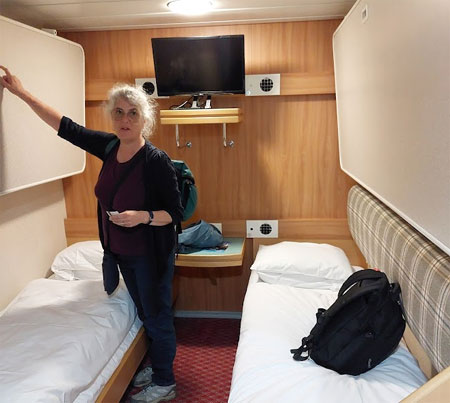
My wife, pointing to one of the upper bunks in the Room-for-Four cabin on the Ferry.
Having left a hot and sunny Glasgow behind, I was looking forward to the cooler and greyer climate of Shetland. I was, therefore, disappointed (not exactly the right word) when we found Shetland experiencing their hottest and sunniest June. Ever. And they didn’t quite know what to make of it. I won’t say they were milling around, gaping up at the sky, wondering why it was so blue, and pointing trembling fingers at the sun, unsure of what that big, yellow ball was, but I think they might have done so if we hadn’t been watching them. As it was, I’m pretty sure—after a few unrelenting days of tropical-like weather—the locals secretly gathered one night while we were all asleep and performed a ritual sacrifice to the weather gods. Though, if they did, it didn’t do any good.
We had breakfast on the ship, got on the coach, left on our tour, and immediately went off piste, making an unscheduled stop at something called a Broch, which is what people who lived a long, long time ago used to live in. It was an interesting introduction to the archaeology of the island, and it didn’t take too long to get there. (Nothing takes too long here; the island is only 40 miles from end to end.)

Inside the Broch: originally, it would have had a roof on it, and the stairs were put in for the tourists’ convenience.
From there we went all the way down to the southern tip of the island, to Sumburgh Head, where there is a lighthouse (closed) and magnificent cliffs with nesting birds, like Puffins. It was spectacular, and very near an airport. So near, we had to drive across a runway to get there.
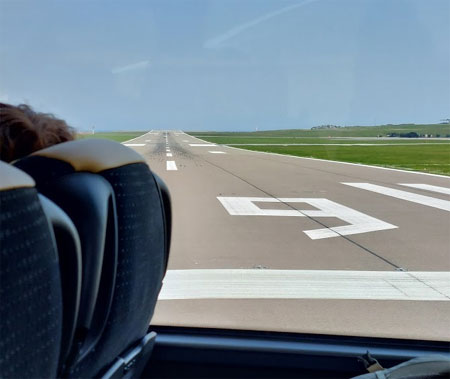
Driving across the runway, and watching for planes.

Spectacular scenery.

Posing Puffin.
After Sumburgh, we went back across the runway to Jarlshof, an archaeology site unique both for what it contains, and how it was discovered. There had been a settlement there since the Iron Age, and subsequent residents made their marks and moved on, until a 1600s farmhouse was built, and left to ruin.
And that’s how it remained until the late 1800s, when a severe storm ripped up the coast and uncovered a priceless treasure trove of ancient dwellings (if you’re an archaeologist), or a big pile of rocks (if you’re someone like me). The site is huge, and contains examples of homes from the Stone Age right up to relatively modern times.

What makes Jarlshof unique is the range of buildings. Here, for those
with a PhD in archaeology, are settlements from the time of the Flinstones
to, say, a long, long time ago.
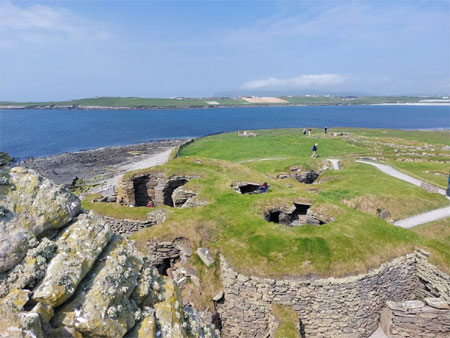
Here you can see something of the size of the site, as well as the number
of disparate dwellings, and the fact that the sun is shining and the sky is blue.
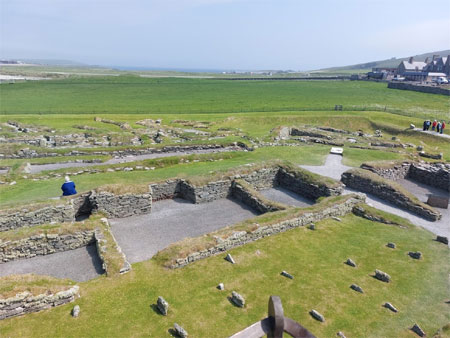
These ruins are from the Roman era, after they invented straight lines.
There was a swanky hotel within sight of Jarlshof (and not much else, so I don’t know who stays at the hotel or why) and we all went there to have lunch. After that, our tour director, Sue (a very nice woman, organized, personable, all the things one likes in a tour leader, and nothing like TM from our Portugal trip), had Jason, our bus driver, take a detour that took us down some impossibly narrow roads past some impossibly stunning scenery. We couldn’t stop for photos, however, as we would have made the road impossibly impassable if we had.

Stunning scenery, scary road.
We then visited Scalloway, a scenic but tiny town with a quaint little museum, and we were given two hours there when one would have been too much.

Scalloway, quaint but quiet.
But it was a nice day, and we got to our hotels on time. The group is split between two hotels because some of us—my wife and I, and another couple—booked too late to get into the more historic Busta House Hotel, so we were checked into the perfectly adequate Brea, a 2-star hotel masquerading as a 4-star. It’s nice, however, the rooms are bigger than at the Busta (or maybe Sue just told us that to make us feel better), and it’s not reputedly haunted. At any rate, we had dinner at the Busta, so we got to see how swanky it was, and enjoy an elegant dinner.
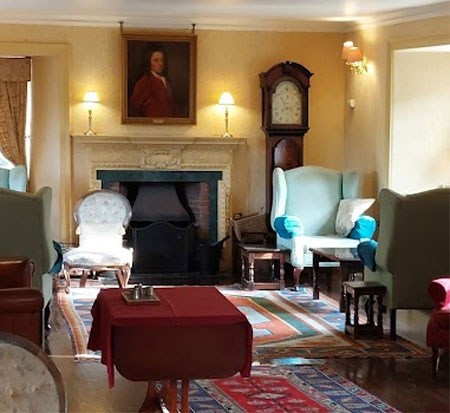
The Busta House Hotel: posh furnishing, no ghosts.
And no one saw any ghosts.
The following morning, while waiting for the bus outside the Brea Hotel, a man—apparently a local—came up to us and asked if we had five minutes. We did, and as it would seem rude to say, “No,” we followed him. He led us to his house across the road, then around the back, to an interesting-looking shed. He seemed keen to show it to us, but all I could think of was the scene in The Lovely Bones where the creepy neighbour lures Susie Salmon into a hideout he made. Then he rapes and kills her. My wife, however, didn’t see that film, and therefore walked straight into the shed, followed by the killer, I mean, the harmless homeowner. Resigned to my fate, I went in, as well, hoping I could either keep her safe or, worst case, be a witness for the prosecution.
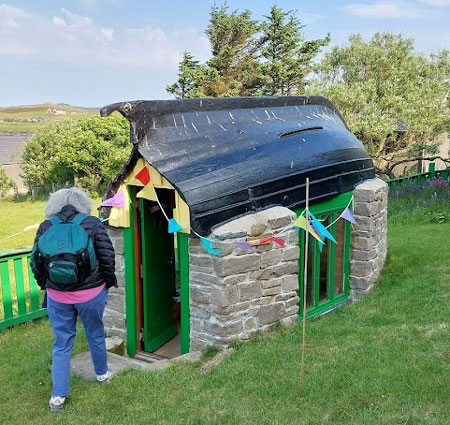
My wife, walking into the kidnapper’s shed.
As luck would have it, and as you all know by now, he didn’t murder and dismember us, and stuff our body parts into a safe; he was simply a craftsman, justifiably proud of his work. It was a stunning shed, made from an old boat, and I was impressed, but I still felt better when we were back outside and I had room to run.
Once on the road, and safe from serial killers, we set out to tour the northern part of the island (Shetland is made up of a number of islands; our tour is confined to the main one). Our first stop, about five minutes away, was Mavis Grind, which is nothing more than a tiny isthmus that keeps Shetland Island from being Shetland Island North and Shetland Island South, but it was surprisingly alluring. It is 200 feet wide and only about 300 feet long. They claim you can throw a stone from the North Sea to the Atlantic Ocean there. I cannot, but there are probably people who can, though I wouldn’t recommend it, as the A970 is very busy, and you might hit a lorry.
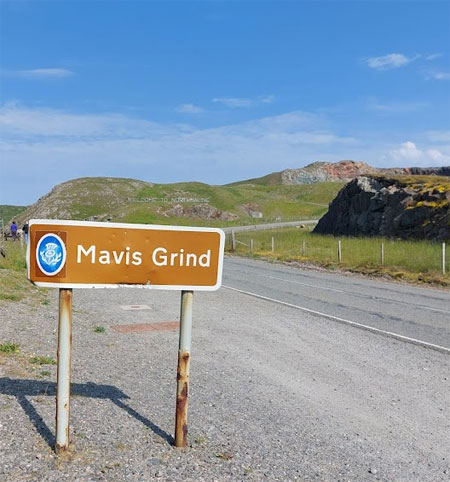
It has a welcome sign…
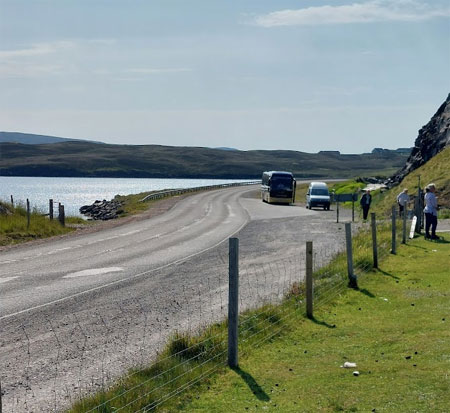
…bus parking, hiking trails, scenic overlooks…

…and it’s only about 220 feet wide.
From there, we travelled on to Eshaness, where there is a lighthouse and some amazing cliffs. It reminded me of the Cliffs of Moher and, once again, the weather was clear, sunny and hot. Sue did tell us, however, that she had taken groups there when the weather was so bad, she didn’t allow them off the bus for fear they’d be blown into the sea.
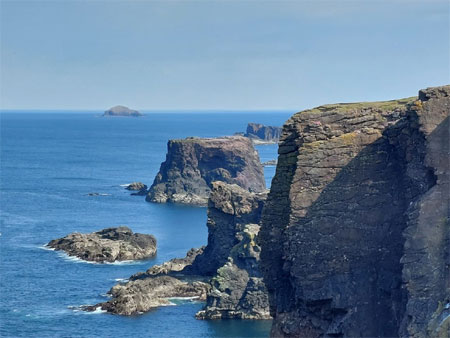
The Cliffs of Eshaness.

Members of our tour, not being blow over the edge. Notice the short-sleeved shirts.
When we returned to our hotel, we got some free time in Lerwick. Being Shetland fans—and having been informed that Lerwick was where the lead character, Jimmy Perez, lives—we took a walk along the waterfront to find his house. It should have been easy, there is only about 100 yards of historic buildings that they artfully shoot from different angles to make it look like all of Shetland and Lerwick look that way. We managed to take photos of nearly everything, but completely missed his house. After looking it up on Google to find out where, exactly, it was and what, exactly, it looked like, we went back.

Shetland, the show.
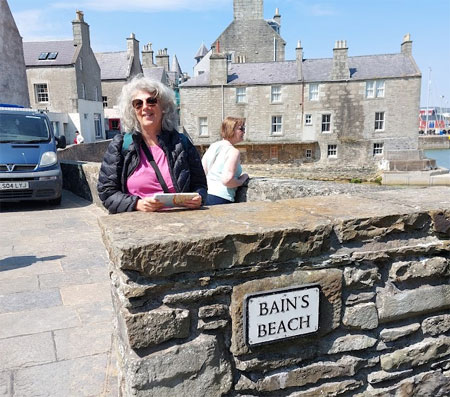
Shetland, in real life. That’s Bain’s Beach, a common setting in the show.
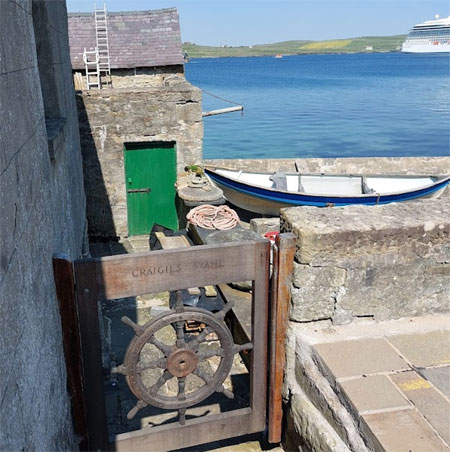
Jimmy’s House.
I took two pictures, then a man—apparently a local—came up to me. Again. This time, instead of wanting to show me his shed, he asked if I was a Shetland fan. I said I was. Then he offered to take a photo of me and my wife in front of Jimmy Perez’s house. With a bit of trepidation, I allowed him to take my phone (I did not hand it to him, he simply plucked it out of my hand).
“Stand there,” he said, backing up. “No, come this way. Stop. Yes, there.” And he backed up some more.
Just as I was, myself, thinking it, my wife asked, “How fast can you run?”
I thought I could catch him if he tried anything, especially as he had a limp. Or was that what he wanted me to think?
“Back up just a little,” he said, making me even more suspicious.
Then he clicked a few photos and gave me my phone back.
I thanked him, and didn’t feel guilty for what I had been thinking about him. I mean, really, what was I supposed to think?

Me and my wife, standing in the vicinity of Jimmy Perez’s house, and
getting ready to run after the guy who has my phone.
At the appointed time, we boarded the bus, which took us to the ferry, where we had dinner, and watched Fair Island slide by, before landing in Orkney at 11:00 pm. It was nearly midnight when we got to our hotel, but it was still light out.

Looking out over Fair Island.
So, I took a picture to prove it.
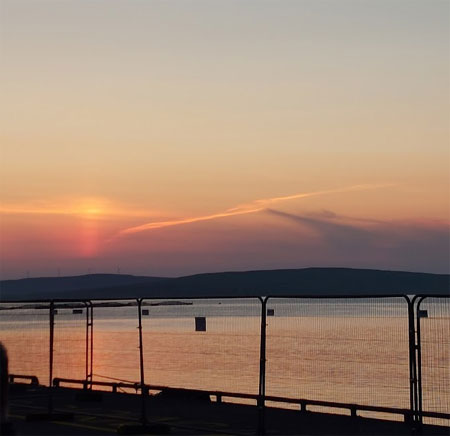
This is 11:00 at night.